

Moving from Cape Cod
to Mexico
Small World
by Rena Lindstrom

Tilting and Drifting and Practicing
Here’s an interesting fact from Wikipedia:
According to the Fédération Aéronautique Internationale’s rules, for a flight to compete for a round-the-world speed record, it must cover a distance no less than the length of the Tropic of Cancer as well as cross all meridans and end on the same airfield where it started.
My son and I crossed the Tropic of Cancer in early May on our drive from Tepoztlan, Mexico, where I live (18° 58'), to Austin, Texas, where he lives (30° 17'). As we sped north on the autopista, past the sign marking our movement from the Tropics to the Subtropics, I rattled him a bit when I suddenly shouted Stop! Go back! We have to take a picture!
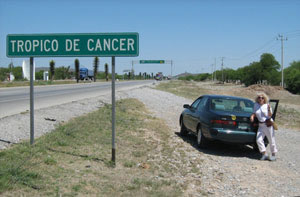
There was an intuitive sense of significance. I had crossed this invisible line many times on winter flights from Boston to Costa Rico in years past, and when I flew to Chiapas last spring on a Global Exchange study tour of the indigenous rights movement there; and again, driving with friends from Austin to Tepoztlan last November. But this time I am made acutely aware of the territory I am crossing. Here was a sign.
I remember my father saying to me once, “We want to give you latitude, but you have to be willing to accept responsibility.” This was a discussion about my perceived lack of the latter. Now I’m wondering how the word latitude came to be both an imaginary line noting distance from the equator, and a permitted freedom. Perhaps it has to do with the idea of limits and boundaries.
I was crossing the Tropic of Cancer, and I was happy. Is it because, as Martín might say, at last I sat down in reverence for the Great Mother who nourishes me and wept and wept the beautiful song of praise? Is it because I know that I am accountable for my own happiness and responsible for my own change, for achieving it or giving up on it, or drifting, unaware or deluded, into a life that defines me, incompatible with my true self? Or worse, breaks my spirit?
In The Art of Happiness, the Dalai Lama teaches that happiness is a state of my own mind, and I can change my mind through practice. In fact, my mind can only be changed by myself…no condition or miracle is going to do it. In retrospect, I can always see how my self-absorption has taken happiness hostage, but when I’m in it, I can’t see a thing but ME. That’s the value of practicing meditation . . . awareness.
So now I am not drifting. I have made up my mind to be happy. I have signed a lease. “Freedom,” psychoanalyst Allen Wheelis says in his provocative little book How People Change,” is the awareness of alternatives and the ability to choose.”
Or maybe it’s a simple matter of balance. Throw out some heavy baggage and my little life tilts into the Hemisphere of Happiness.
Speaking of drift, I read that the two Tropics are currently drifting toward the equator by about 15 meters (49.21 feet) a year, explained by the fluctuation of the earth’s tilt as it encircles the sun. That’s a shrinking band of 98 feet all the way around the world! Right now the Tropic of Cancer lies at 23°27' north of the equator.
Here’s what worries me. I know that the coca tree only grows within 20° either side of the equator. Is this drift going to affect my access to dark chocolate?
Oh, no problem. When I read further, I see that the drift occurs between 22.5° and 24.5° on a long term cycle of 41,000 years.
Whew!
http://www.shamanchocolates.com/
Rena Lindstrom is originally from North Carolina. In October, 2007, after 15 years living in Provincetown, she put her belongings in storage and moved to Mexico. She hopes her essays will stimulate examination and gather honest responses from Cape Cod women and others, whatever their gender, all over this small world.
Check out Rena's blog at:
http://renalindstrom.blogspot.com/
www.renalindstrom.com
Send comments to CapeWomenOnline
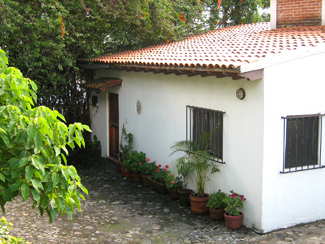 Rena's house in Mexico
Rena's house in Mexico
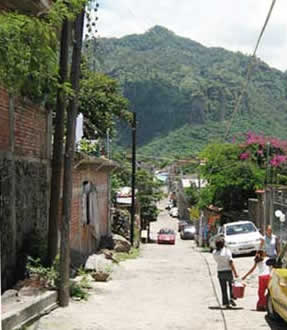
Going to market.
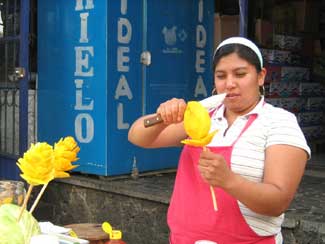 Mango Flower
Mango Flower
Photos of Mexico by Rena Lindstrom
_________________________________________________
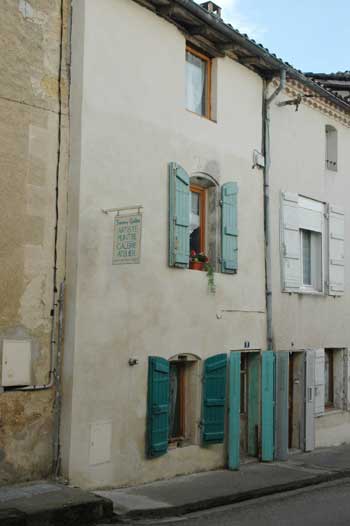 Franny Golden's house in Francescas, France.
Franny Golden's house in Francescas, France.
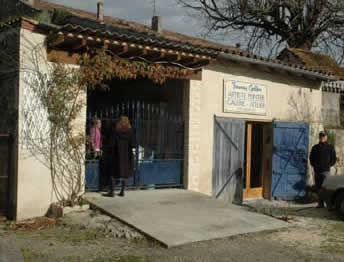 Franny Golden talking to her neighbor in the back of her house, showing her "atelier," or art studio (blue barn door).
Franny Golden talking to her neighbor in the back of her house, showing her "atelier," or art studio (blue barn door).

Brewster Artist Franny Golden
Art and Travel Lead
Franny Golden
to France
by J. Talin
ART AND TRAVEL have opened many doors for Franny Golden. Her first voyages were ones of the mind when, as a young adult in Detroit, her journals and sketch books started “as a place to hide.” Since then, travel has been inseparable from her art, and the record of her most recent voyages can be discovered at her gallery in Brewster, where her paintings of Turkey, Mexico and France illuminate the walls.
In the early 1990s, Franny set out to Turkey where she taught English for four years, and where she painted in her studio in Istanbul. In Turkey, she fell under the spell of its golden hues and its domes, spheres and arches. When her teaching job was over and she was on her way home, Franny visited friends living in the South of France, friends who had helped her throughout her personal life, including the construction of her house and studio in Brewster. She explained, “That part of France felt rich and safe,” and after her visit, she decided to buy a house there, in the Bastide village of Francescas, between Toulouse and Bordeaux, near the town of Agen. For ten years she saved money, and when she had sufficient funds, she bought a “simple village house on a narrow street, near my friends, but away from other foreigners.”
Once there, her art introduced her to the people of her new home. It began when she repainted the walls in her kitchen with murals reminiscent of large tiles, each representing a vegetable, fish, herb or other food item. When her new neighbor MarieJeanne saw the murals, she cried “chouette,” (roughly translated as “Cute!”) and spread word about them throughout the small village. Before long people from Francescas were asking to see them. The mayor’s secretary came first, followed by the mayor. The postmaster came with his assistant, and the chef at the local two star restaurant came and called them “fantastique.”
“If I run out of food,” Franny joked to the chef about her murals, “I can always eat the walls.”
“If you ever run out of food,” he reassured her, “Just come to me.”
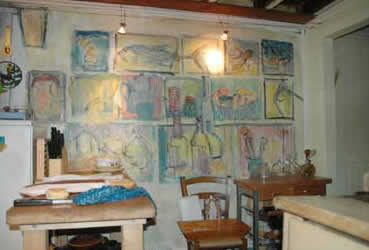
Franny's kitchen
It is not an accident that the people of Francescas appreciate art and artists. “Art is everywhere in France,” says Franny. “It is more integrated into the life and even into the genes of the people. They value it and the people who do it.” In fact, the village of Francescas is located in an area where creative art was born: on its limestone plateau cut open by cliffs, swift rivers, and caves, as the glaciers of the last ice age melted over 12,000 years ago, our hunter-gatherer ancestors followed herds of bison, mammoth and antelope north. Deep in the limestone caves in places like Lascaux and Les Eyzies, the first artists, unknown primitive painters, carved and colored pictures from their memory of the animals around them, and these simple but elegant images stand as the first known works of western art. These cave paintings have been an inspiration to Franny Golden.
Franny has written that her paintings “are visual journals . . . times and moments from my life.” She begins her work with sketch books from which she discovers images that can be worked into studio paintings. One such sketch book is an accordion book which one of her friends has described as being her “cave painting.” It is a stream of nomadic images, linked by color and the musical flow of form that unfolds magically page by page. From this book, she took an image of a wrought iron fence and worked it into a painting called Convent Stairway (or Stairway to Heaven), a darkly evocative painting of a Madonna and child which captures a moment of constrained energy.
Back in her studio in Brewster after recent trips to France, Franny has taken scenes from the places she visited and worked them into a Lot and Garonne series of multimedia works. Using sketches, she created her “Saint Colombe Triptych,” which consists of three views of the village church, linked by form and the flow of color. This painting, like many of her works, contain frames within frames, offering multiple perspectives on an object or color. Iconography has fascinated her, particularly since her stay in Turkey, and frequently she punctuates her work with smaller scenes or variations in the form of predellas, which are found on Renaissance altars, depicting scenes from a saint’s life. When she was in Paris, she gessoed wooden vegetable boxes from the market and completed a series of Paris scenes; she also used egg cartons and doilies to portray her reaction to that city and its art.
In the small village of Francescas, Franny ’s house opens onto a small courtyard, behind which there is a barn. She has converted it into a gallery and art school, and its first floor into a studio. Franny had taught painting in France in the past, and now teaches here. She is inspired by the area and loves its richly saturated and ancient colors that were used throughout the Renaissance and Middle Ages in stained glass, frescoes and paints. She loves the quiet of its gently rolling hills which are crowned by villages with narrow streets around central squares that become busy with markets each week. It is an area known for its Armagnac brandy, the quality and freshness of its food, and for its winding roads beside fields of sunflowers and ripening grain. It is an area which is certain to earn a personal place in Franny Golden’s art.
Jim Talin is co-owner of Talin Bookbindery in Yarmouthport. This article was first published in Cape Arts Review magazine.
Find out more about Franny Golden at www.frannygolden.com